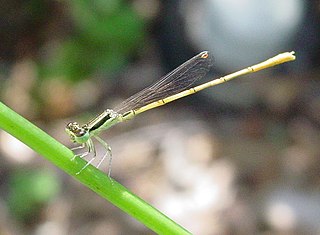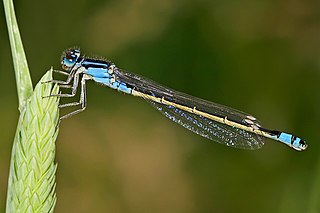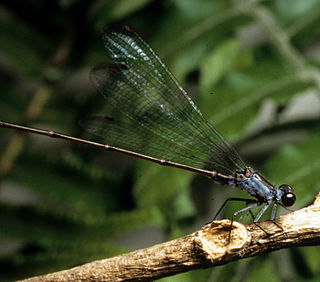
Damselflies are flying insects of the suborder Zygoptera in the order Odonata. They are similar to dragonflies but are smaller and have slimmer bodies. Most species fold the wings along the body when at rest, unlike dragonflies which hold the wings flat and away from the body. An ancient group, damselflies have existed since at least the Lower Permian beginning about 299 million years ago, and are found on every continent except Antarctica.

Glen Canyon Park is a city park in San Francisco, California. It occupies about 70 acres (28 ha) along a deep canyon adjacent to the Glen Park, Diamond Heights, and Miraloma Park neighborhoods. O'Shaughnessy Hollow is a rugged, undeveloped 3.6 acres (1.5 ha) tract of parkland that lies immediately to the west and may be considered an extension of Glen Canyon Park.

Enallagma cyathigerum is a species found mainly between latitudes 40°N and 72°N; It is widely distributed in the Palearctic, and the Nearctic species Enallagma annexum was at one time considered to be synonymous with it. The species can reach a length of 32 to 35 mm. It is common in many different countries including Russia, Sweden, Norway, Finland, the United States of America, and South Korea. Damselflies are an important link between the health of the aquatic ecosystem and its response to climate change.

The large red damselfly is a species of damselflies belonging to the family Coenagrionidae. It is native to the western Palearctic.

The blue-tailed damselfly or common bluetail is a damselfly, belonging to the family Coenagrionidae.

Ischnura senegalensis, also known variously as common bluetail, marsh bluetail, ubiquitous bluetail, African bluetail, and Senegal golden dartlet, is a widespread damselfly of the family Coenagrionidae. It is native from Africa, through the Middle East, to southern and eastern Asia.

The citrine forktail is a damselfly of the family Coenagrionidae.

Ischnura aurora, the gossamer damselfy or golden dartlet and also known as the aurora bluetail, is a species of damselfly in the family Coenagrionidae.

Amanipodagrion gilliesi is a species of damselfly. Its monotypic genus Amanipodagrion was formerly in the subfamily Argiolestinae of the flatwing damselfly family (Megapodagrionidae). As a result of molecular phylogenetic studies by Bybee et al. in 2021, it is now in its own family, Amanipodagrionidae.

Ischnura is a genus of damselflies known as forktails in the family Coenagrionidae. Forktails are distributed worldwide, including various oceanic islands. The males have a forked projection at the tip of the abdomen which gives the group their common name.

Megalagrion leptodemas, commonly referred to as the Crimson Hawaiian damselfly, is one of the rarest and most endangered Megalagrion species that is endemic to the island of Oahu in Hawaii. It is currently labeled as endangered by the ESA and critically endangered on the IUCN Red List. The general biology of Crimson Hawaiian damselflies is similar to other narrow-winged damselflies. Megalagrion leptodemas used to be found in the mountains of Ko’olau and Wai'anae but is now only found in four watersheds in the Ko’olau Mountains. The species is threatened by habitat loss and non-native species. They have limited habitat and small, scattered populations which can affect their future population stability. Conservation efforts for this species should concentrate on both habitat management and control of invasive species.

Megalagrion nesiotes is a species of damselfly in the family Coenagrionidae. Its common name is flying earwig Hawaiian damselfly. In the past, the flying earwig Hawaiian damselfly lived on the islands of Hawaii and Maui, in the U.S. state of Hawaii. Currently, there is only one population left in east Maui. Limited distribution and small population size make this species especially vulnerable to habitat loss and exotic species invasion. The flying earwig Hawaiian damselfly was last found in 2005. Little is known about this species because of the lack of observation. In 2010, the species was federally listed as an endangered species in the United States.

Rambur's forktail is a member of the damselfly family Coenagrionidae. Males are green with blue on abdominal segments 8 and 9. Females are orange-red, olive green, or similar to males in coloration. This is the most widespread New World Ischnura, occurring throughout the Americas from the United States to Chile, as well as Hawaii and the Antilles.

Eastern forktail is a member of the damselfly family Coenagrionidae.

Ischnura erratica, the swift forktail, is a species of damselfly in the family Coenagrionidae. It is native to the Pacific Northwest, ranging from British Columbia to northern California.
Ischnura chingaza is a species of damselfly in the genus Ischnura, of the family Coenagrionidae, endemic to the Eastern Ranges of the Colombian Andes. It was first described by Emilio Realpe in 2010.

Ischnura demorsa is a damselfly in the genus Ischnura ("forktails"), in the family Coenagrionidae. The species is known generally as the "Mexican forktail". The distribution range of Ischnura demorsa includes Central America and North America.

Ischnura rubilio, western golden dartlet, is a species of damselfly in the family Coenagrionidae. It is found in Indian subcontinent and Iran.

Argia vivida, the vivid dancer, is a species of narrow-winged damselfly in the family Coenagrionidae. This species is commonly found in springs and forests Central America and North America. Argia vivida inhabit areas of diverse temperatures due to thermoregulation. The species is also considered the state insect of Nevada.



















